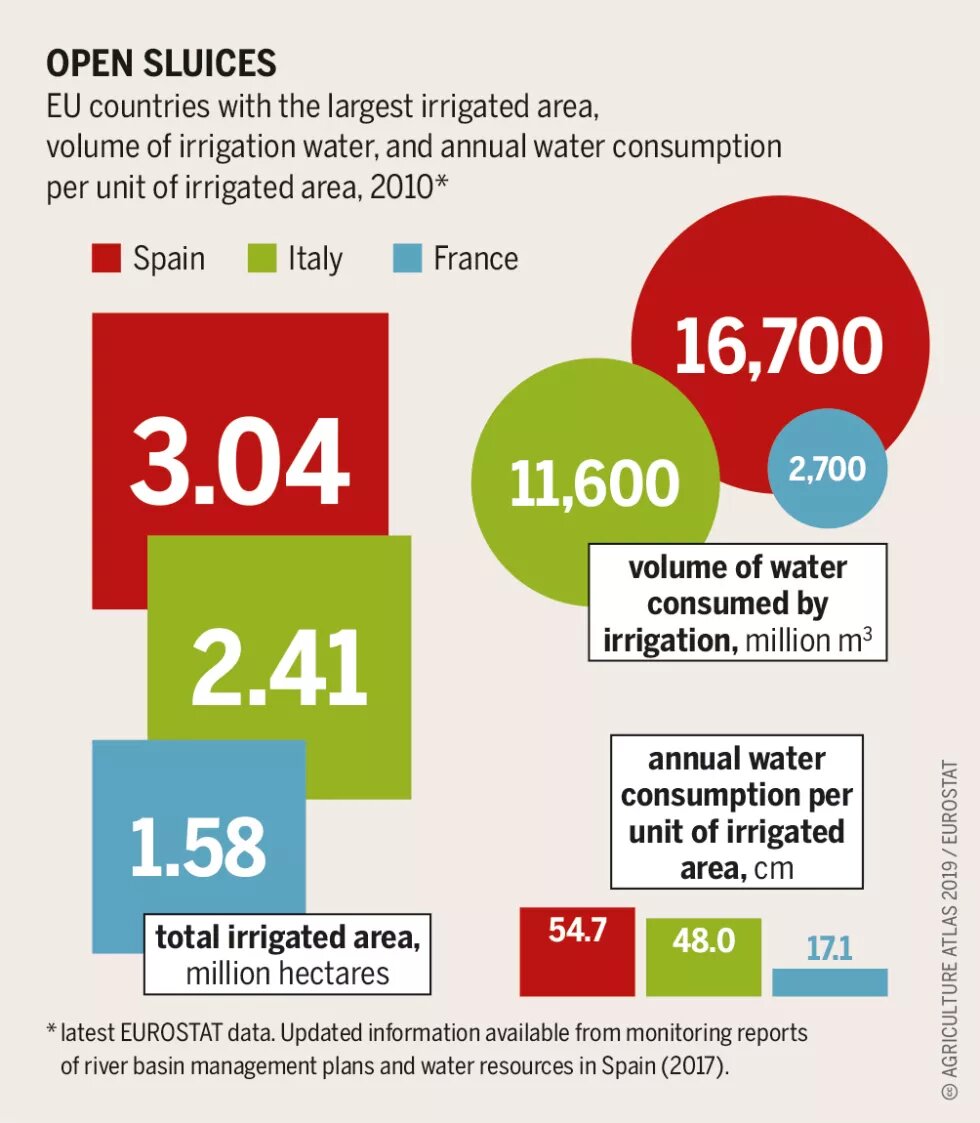

Crop growing in southern Europe long relied on a combination of rainfed agriculture and traditional irrigation methods. But since Spain joined the European Union, its rainfed farmland area has shrunk by 23 percent because of the low productivity in the dry Mediterranean areas and the limited support from the Common Agricultural Policy. At the same time, the disappearance of many traditional irrigation systems has led to the loss of their valuable agroecosystems. About 4 million hectares of unirrigated farmland, some of great environmental value, have been abandoned, while land irrigated with modern methods has grown by 700,000 hectares. Irrigation systems now water 22 percent of Spain’s agricultural area, supporting one-third of both the farm jobs and the agricultural value added.
Traditional irrigation systems, some dating back millennia, make up 25 percent of Spain’s irrigated area. They are found in river valleys and mountain areas, on soils that are naturally high in fertility. They have been used mainly for orchards and fruit-growing, and form agroecosystems of high environmental value. The ancient water channels represent important ethnographic and cultural heritage. But they are in decline because of their low profitability in current market conditions. Many are being swallowed up by growing towns.
Between 1940 and 1980, extensive irrigation schemes were established in inland areas as a result of government planning. Big water infrastructure projects using large underground aquifers were used as an economic development strategy for rural areas. They account for 55 percent of the total irrigated area and are used mainly for annual crops, and more recently for olive plantings and vineyards. Profits from such areas are generally low, and they rely heavily on Common Agricultural Policy support. Although they create few jobs, they are socially and economically important in many inland areas. The irrigation schemes put a lot of pressure on rivers, wetlands and groundwater because of their size, the structures used to harvest water, the volumes of water abstracted, and as sources of pollution.
Intensive irrigation schemes occupy 20 percent of the irrigated area. They are concentrated mainly in the coastal regions of the basins of the rivers Ebro, Júcar and Segura (which flow into the Mediterranean), and the Guadiana and Guadalquivir (which flow south into the Atlantic), and along the coast of Andalusia. Recent decades have seen a major expansion of fruit trees, subtropical crops, berries, flowers and vegetables. While these crops are both productive and profitable, they have a significant ecological impact because they rely heavily on technical inputs and consume large amounts of resources. Many crops are raised in greenhouses, which use inputs such as fertilizers, plastics and artificial growth substrates, consume a lot of energy, and have a major environmental footprint. Although the farms are often run by families, the production processes, technological inputs and marketing to European consumers are all controlled by big business, which also run their own farms using poorly paid workers. The uncontrolled expansion of such farms has led to the ploughing up of natural areas (the Doñana National Park in Andalusia) and the degradation of wetlands (the Mar Menor saltwater lagoon in Murcia).
Irrigation accounts for 80 percent of Spain’s water consumption and is one of the main factors threatening aquatic ecosystems through the overuse and contamination of aquifers, the degradation of wetlands, and the reduction and alteration of river flows. Agriculture causes widespread pollution: it stimulates the eutrophication of water bodies and contaminates drinking water with nitrates and pesticides. Irrigation infrastructure such as dams, reservoirs and canals and the concentration of landholdings cause additional environmental problems, which in turn are aggravated by further planned increases in irrigation.
Climate change is expected to cause a decline in water inputs and more irregular and torrential rain. This is likely to have serious impacts on water resources and soil erosion, while increasing the demand for water needed to grow crops. Spain’s irrigated area is already larger than the area current water supplies can sustain. The Common Agricultural Policy does not contribute to improving the environment, as its support programmes favouring intensive farming methods to the detriment of rainfed cropping and more sustainable traditional systems.
In order to reduce the pressure on water, Spain’s agricultural policy has emphasized the modernization of irrigation systems, switching from gravity schemes to using piped water under pressure. In the last 30 years, about half of the irrigation schemes in Spain have been modernized, about 60 percent with public funds. But, in general, this has not resulted in saving water. Since water rights are not subjected to a downwards adjustment after a project is completed, less water is returned to rivers, cropping is frequently intensified, and the irrigated area is expanded. Total water consumption may even rise after a system is modernized. By reducing return flows and the local humidity, these projects degrade the existing natural vegetation. They also greatly increase the demand for energy to get water to the plants.
A new Common Agricultural Policy is needed. It must take the peculiarities of Mediterranean farming into account, support high-value natural systems, and promote the sustainable use of irrigation water to restore rivers, aquifers and wetlands.


